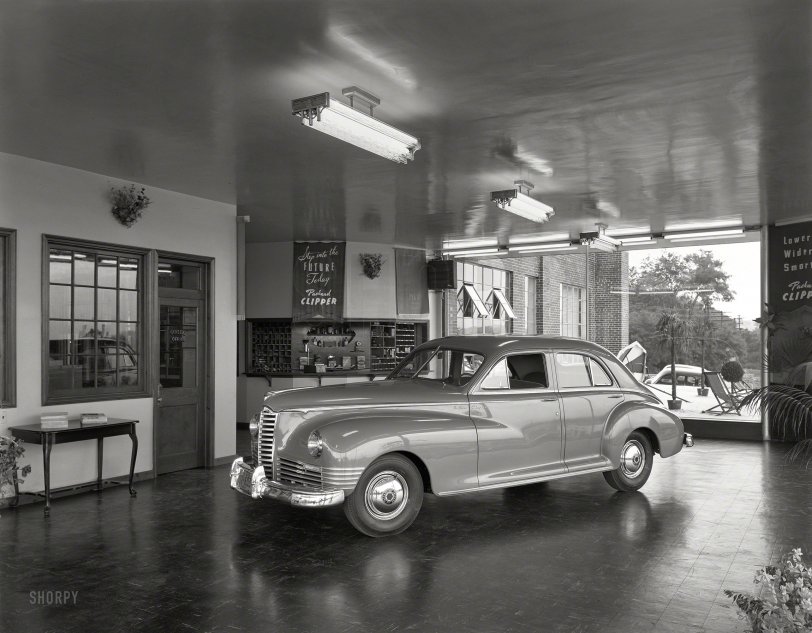


Framed or unframed, desk size to sofa size, printed by us in Arizona and Alabama since 2007. Explore now.
Shorpy is funded by you. Patreon contributors get an ad-free experience.
Learn more.

- Texas Flyer wanted
- Just a Year Too Soon
- WWII -- Replacing men with women at the railroad crossing.
- Yes, Icing
- You kids drive me nuts!
- NOT An Easy Job
- I wonder
- Just add window boxes
- Icing Platform?
- Indiana Harbor Belt abides
- Freezing haze
- Corrections (for those who care)
- C&NW at Nelson
- Fallen Flags
- A dangerous job made worse
- Water Stop
- Passenger trains have right of way over freights?
- Coal
- Never ceases to amaze me.
- Still chuggin' (in model form)
- Great shot
- Westerly Breeze
- For the men, a trapeze
- Tickled
- Sense of loneliness ...
- 2 cents
- Charm City
- What an Outrage
- Brighton Park
- Catenary Supports
Print Emporium
Lower Wider Smarter: 1946

September 12, 1946. Washington, D.C. "Showroom at Superior Motors. Client: Griffith-Consumers Co." Step into the FUTURE today with the Packard Clipper! 8x10 acetate negative by Theodor Horydczak. View full size.
Just a bit early for Father's Day
The war was over. Rationing was slowly fading away. My grandmother was pushed off of her wartime job working on airplane engines so that returning servicemen, and Packard, could get back to the business of building cars.
But my dad was there in the big plant on East Grand Boulevard, working his way through college on the night shift, with a locker full of books to study on his breaks. Still to this day, at the age of 90, every time he sees an old Packard or Hudson (another plant where my father worked in those years) he says "I think I built that one".
End of an era
Although Packard introduced the Clipper in 1941, 1946 was the first model year that saw total abandonment of the classy vertical louvered grille that had distinguished most Packards starting with 1933, and even earlier on some models. Once Clipper-type styling got perfected with the Custom line in 1950, that also got abandoned. And it was downhill from that point on. Already joined with Studebaker, the last authentic Packard was built in June 1956. The marque that was once among the top rated "3 Ps" (Packard, Peerless and Pierce-Arrow) amounted to little more than rebadged Studebakers for the next two years. Then, nothing.
Just Add Water
Note the faux-seashore complete with sand, palm trees and beach umbrella.
Some future!
A decent car, the Packard Clipper, though far from the marque's pre-war standards of luxury. The body is a pre-war holdover, and mechanically the small straight-8 engine, though smooth and reliable, was hardly a harbinger of things to come either.
Except for the new brands -- Kaiser, Frazer, the token production of Tucker -- it was 1947 before any radically new coachwork was being produced by a major manufacturer: Studebaker, followed a year later by Hudson and then Nash. Obviously the majors, having a heavy investment in their 1941-42 body dies and facing a seller's market after the war, held on the longest, badge-engineered pre-war cars until 1948 and '49.
Though there was much reason for euphoria after the war, rationing did not end immediately upon V-J day, though by late '46 I suspect it had. I recall being punished by my father, recently returned from the Pacific, for ruining a rationed item by attempting to blow away a cigarette ash he'd dropped on the tablecloth. (Yes, smoking and eating were complementary activities in the winter of 1945-46). Instead, I blew the whole tray's worth of Chesterfield ashes onto a stick of still-rationed butter.
Our relationship went downhill from there.
Happy days are here again!
I turned 7 on that very day. The war was over, soldiers were returning home, no more food rationing, families and lovers were reuniting, prosperity was booming and America had emerged victorious. I wish the spirit of that exhilarating, invigorating and revitalizing era could have been permanent. If I could keep time in a bottle, that would fill one of my treasured bottles. Life was good.
[Unless you were dead. -Dave]
























On Shorpy:
Today’s Top 5